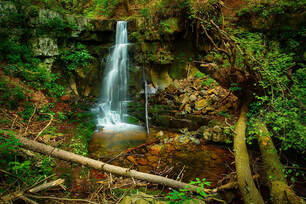
Press Release from the Southern Environmental Law Center, Friends of Shenandoah Mountain, and Virginia Wilderness Committee
For Immediate Release: July 27, 2023
Contacts:
Eric Hilt, Southern Environmental Law Center, 615-622-1199 or [email protected]
Lynn Cameron, Friends of Shenandoah Mountain, 540-234-6273 or [email protected]
WASHINGTON D.C. — On Thursday, Senator Tim Kaine (D-VA) and Senator Mark Warner (D-VA) introduced the Shenandoah Mountain Act of 2023, which would designate more than 92,000 acres of the George Washington National Forest as the Shenandoah Mountain National Scenic Area. Like last year’s version, the bill, if enacted, would preserve the majestic forests, spectacular vistas, and more than 150 miles of trails on the western edge of the Shenandoah Valley.
The new designation would allow forest visitors to continue enjoying these incredible lands – which are separate from and to the west of Shenandoah National Park [EH1] – as they do today, while prohibiting logging and industrial development like gas drilling and pipeline construction.
“National Scenic Areas strike a great balance between recreation and preservation,” Friends of Shenandoah Mountain Co-Chair Lynn Cameron said. “This unique designation ensures that hunters, hikers, anglers, mountain bikers, and many others will be able to continue to enjoy the exceptional landscapes for generations to come.”
“The Shenandoah Mountain area is one of the largest stretches of undeveloped land east of the Mississippi River, and boasts some of the most spectacular, uninterrupted views in the Southern Appalachians,” Southern Environmental Law Center Senior Attorney Kristin Davis said. “Designating this as a National Scenic Area will protect these incredible public lands and all they have to offer.”
The proposal is the product of two decades of work and has broad public support from more than 400 local businesses, organizations, and faith groups who recognize the immense benefits the new designation will have on nearby communities. Rockingham and Augusta Counties, as well as the nearby cities of Staunton and Harrisonburg, have also endorsed the proposal. The U.S. Forest Service has recommended the designation of a national scenic and wilderness areas on Shenandoah Mountain.
“This bill is the product of 20 years of collaborative work from an incredibly diverse group of local conservationists, recreation groups, timber industry representatives, hunters, and anglers. Over that time, people with different outlooks on forest management came together and agreed that this exceptional place deserves the permanent protection that a National Scenic Area will provide,” Friends of Shenandoah Mountain Co-Chair Thomas Jenkins said.
The Virginia Tourism Corporation estimates people visiting counties near Shenandoah Mountain spend more than $720 million a year and that the tourism industry employs more than 6,500 people. The Shenandoah Mountain National Scenic Area will attract even more visitors and provide a boost to the region’s growing tourism industry. The designation will also protect important drinking water sources for people living in Harrisonburg, Staunton, and many other communities downstream.
The Shenandoah Mountain National Scenic Area would also include four Wilderness Areas, totaling around 28,000 acres of new Wilderness, which would have the highest level of protection public lands can receive. Wilderness Areas are popular among people in the South, and a recent study showed 88 percent of Southerners surveyed said they support more Wilderness designations.
“Wilderness Areas are some of the nation’s least developed lands and offer a one-of-a-kind experience to visitors looking for solitude. These protections are becoming increasingly important as more and more areas – especially in the Eastern U.S. – are being rapidly developed, leaving fewer pristine and untouched landscapes,” Mark Miller, Executive Director of the Virginia Wilderness Committee, said.
Important natural resources would also be protected by Shenandoah Mountain National Scenic Area, which lies within a biodiversity hotspot. The area is home to black bear, wild turkey, more than 250 species of birds, and many other species, including rare or endangered species that only live in the Shenandoah Mountain area. Creating this designation would help preserve these habitats, allowing visitors to continue to enjoy the plants and animals that make this area unique.
The introduction of the Shenandoah Mountain Act of 2023 in the United States Senate is just the first step in establishing these much-needed protections for this extraordinary area. In order to permanently protect Shenandoah Mountain, Congress must pass this important bill, and send it to the President for his signature.
For Immediate Release: July 27, 2023
Contacts:
Eric Hilt, Southern Environmental Law Center, 615-622-1199 or [email protected]
Lynn Cameron, Friends of Shenandoah Mountain, 540-234-6273 or [email protected]
WASHINGTON D.C. — On Thursday, Senator Tim Kaine (D-VA) and Senator Mark Warner (D-VA) introduced the Shenandoah Mountain Act of 2023, which would designate more than 92,000 acres of the George Washington National Forest as the Shenandoah Mountain National Scenic Area. Like last year’s version, the bill, if enacted, would preserve the majestic forests, spectacular vistas, and more than 150 miles of trails on the western edge of the Shenandoah Valley.
The new designation would allow forest visitors to continue enjoying these incredible lands – which are separate from and to the west of Shenandoah National Park [EH1] – as they do today, while prohibiting logging and industrial development like gas drilling and pipeline construction.
“National Scenic Areas strike a great balance between recreation and preservation,” Friends of Shenandoah Mountain Co-Chair Lynn Cameron said. “This unique designation ensures that hunters, hikers, anglers, mountain bikers, and many others will be able to continue to enjoy the exceptional landscapes for generations to come.”
“The Shenandoah Mountain area is one of the largest stretches of undeveloped land east of the Mississippi River, and boasts some of the most spectacular, uninterrupted views in the Southern Appalachians,” Southern Environmental Law Center Senior Attorney Kristin Davis said. “Designating this as a National Scenic Area will protect these incredible public lands and all they have to offer.”
The proposal is the product of two decades of work and has broad public support from more than 400 local businesses, organizations, and faith groups who recognize the immense benefits the new designation will have on nearby communities. Rockingham and Augusta Counties, as well as the nearby cities of Staunton and Harrisonburg, have also endorsed the proposal. The U.S. Forest Service has recommended the designation of a national scenic and wilderness areas on Shenandoah Mountain.
“This bill is the product of 20 years of collaborative work from an incredibly diverse group of local conservationists, recreation groups, timber industry representatives, hunters, and anglers. Over that time, people with different outlooks on forest management came together and agreed that this exceptional place deserves the permanent protection that a National Scenic Area will provide,” Friends of Shenandoah Mountain Co-Chair Thomas Jenkins said.
The Virginia Tourism Corporation estimates people visiting counties near Shenandoah Mountain spend more than $720 million a year and that the tourism industry employs more than 6,500 people. The Shenandoah Mountain National Scenic Area will attract even more visitors and provide a boost to the region’s growing tourism industry. The designation will also protect important drinking water sources for people living in Harrisonburg, Staunton, and many other communities downstream.
The Shenandoah Mountain National Scenic Area would also include four Wilderness Areas, totaling around 28,000 acres of new Wilderness, which would have the highest level of protection public lands can receive. Wilderness Areas are popular among people in the South, and a recent study showed 88 percent of Southerners surveyed said they support more Wilderness designations.
“Wilderness Areas are some of the nation’s least developed lands and offer a one-of-a-kind experience to visitors looking for solitude. These protections are becoming increasingly important as more and more areas – especially in the Eastern U.S. – are being rapidly developed, leaving fewer pristine and untouched landscapes,” Mark Miller, Executive Director of the Virginia Wilderness Committee, said.
Important natural resources would also be protected by Shenandoah Mountain National Scenic Area, which lies within a biodiversity hotspot. The area is home to black bear, wild turkey, more than 250 species of birds, and many other species, including rare or endangered species that only live in the Shenandoah Mountain area. Creating this designation would help preserve these habitats, allowing visitors to continue to enjoy the plants and animals that make this area unique.
The introduction of the Shenandoah Mountain Act of 2023 in the United States Senate is just the first step in establishing these much-needed protections for this extraordinary area. In order to permanently protect Shenandoah Mountain, Congress must pass this important bill, and send it to the President for his signature.
Wilderness and National Scenic Area FAQs

Some of our most spectacular federal lands are designated as National Scenic Areas and Wilderness areas. While there are some key differences between them, there are many similarities:
Wilderness is the highest level of protection available for public land. Wilderness areas are some of the nation’s most remote and least developed places. They have a natural character, and the imprint of any prior land uses is substantially unnoticeable.
- Only Congress has the power to designate portions of national forests or other federal lands as National Scenic Areas or Wilderness Areas, and only federal land can be designated. Private lands near or within the proposed National Scenic Area are not included, and there are no private inholdings within the proposed Wilderness areas. Since this land is already federally owned and part of the George Washington National Forest, no land acquisition is required.
- Hiking, camping, backpacking, horseback riding, paddling, birdwatching, and many other forms of recreation are allowed in both the National Scenic Area and Wilderness areas. Hunting and fishing are also allowed in both the National Scenic Area and Wilderness areas. This designation does not affect hunting or fishing rules, which are determined by the Virginia Department of Wildlife Resources.
- The Forest Service can continue to fight fires and damaging outbreaks of insects and disease in both the National Scenic Area and Wilderness areas.
- Most timber harvest and industrial development, such as gas drilling, would be off-limits in both the National Scenic Area and Wilderness areas.
- The proposed Shenandoah Mountain National Scenic Area and Wilderness areas were both developed by and brought to Congress by local citizens, as most successful proposals are.
Wilderness is the highest level of protection available for public land. Wilderness areas are some of the nation’s most remote and least developed places. They have a natural character, and the imprint of any prior land uses is substantially unnoticeable.
- To preserve the wild character of Wilderness areas, timber harvest, permanent roads, drilling, and other development are not allowed. The use of motorized equipment, motor vehicles, or other mechanical transport is normally not allowed, except when necessary for control of fire, insects, diseases, and for search and rescue operations. There are no existing roads in the proposed Wilderness areas.
- Designated Wilderness offers outstanding opportunities for people to enjoy solitude and backcountry recreation, and also protect forested refuges for wildlife and fish, clean water and air, and other natural values.
- Mountain biking is allowed on trails within the National Scenic Area.
- No existing open roads within the National Scenic area will be closed, and visitors can continue to use them, including for scenic drives and to access campsites and trailheads.
- Virginia is already home to three popular National Scenic Areas. The Mount Pleasant, Seng Mountain, and Bear Creek National Scenic Areas contain some of Virginia’s most popular trails, and are popular destinations for camping, fishing, and other recreation.






 RSS Feed
RSS Feed